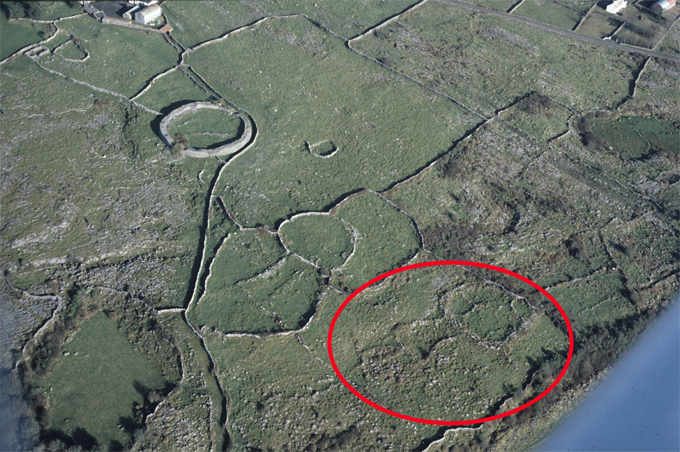County: Clare Site name: CAHERCONNELL
Sites and Monuments Record No.: CL009-030 (not marked) Licence number: 10E0119
Author: Michelle Comber
Site type: Enclosure
Period/Dating: —
ITM: E 523050m, N 699325m
Latitude, Longitude (decimal degrees): 53.039048, -9.147423
The second season of research excavation targeted new areas in the interior of a subsquare drystone cashel-like enclosure in the townland of Caherconnell, the Burren, Co. Clare. A circular cashel lies 30–40m to the north (CL009-030-08), and the main cashel of Caherconnell another 50m or so north of that (CL009:030-10).

Excavated site at Caherconnell (No. 59) circled.
The enclosure is located on a narrow, level shelf, with slightly higher ground to the north and lower ground to the south. This site is within an archaeological complex on the RMP, but not specifically marked or numbered. It is a subsquare or slightly D-shaped drystone enclosure, with visible internal and external features. The walls of the enclosure are of limestone, comprising an internal and external face with slightly smaller stones forming the core, 2.7m wide originally.
This particular site type has not previously been excavated. A number of such sites are known from across the Burren, but nothing is known of their chronology or function. From surface survey they appear to form a ringfort/cashel subtype. This particular subsquare enclosure forms part of an archaeologically rich landscape in and around the townland of Caherconnell.
Three hand-dug cuttings were excavated at the site, all within its interior, with one extending through the entrance to the exterior of the enclosure. Features uncovered in the interior included a subcircular structure/house, part of a possible structure, a number of walls subdividing the space between the structures, and the enclosure entrance. The entrance comprised a passage flanked by the drystone walls of the enclosure, with its surface roughly paved. A fallen lintel was discovered immediately outside the entrance. Associated deposits were rich in faunal remains and a quantity of artefacts was also recovered. The artefacts included bronze, bone and iron dress-pins, iron knives, a socketed and pronged tool, nails and rivets, a buckle, stone and glass beads, a fragment of a rotary quernstone, a stone spindle-whorl, whetstones, a lignite bracelet fragment, a few potsherds, flint and chert tools and waste, a stone axe and a fragment of a second, and several pieces of metal-working slag.
Initial analysis, based on 14C dates from 2010 and recovered artefacts, indicates that the enclosure was used during the early medieval period (7th to 9th century AD), though the material culture contains a prehistoric element. Reasons for its non-circular shape, relatively large size and south-facing entrance are being explored. Did it have a different function, status or even cultural background to the more common circular enclosures?